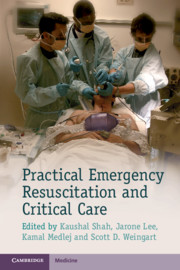21 results
Section 12 - End of life
-
- Book:
- Practical Emergency Resuscitation and Critical Care
- Published online:
- 05 November 2013
- Print publication:
- 24 October 2013, pp 451-456
-
- Chapter
- Export citation
Section 2 - Trauma
-
- Book:
- Practical Emergency Resuscitation and Critical Care
- Published online:
- 05 November 2013
- Print publication:
- 24 October 2013, pp 41-114
-
- Chapter
- Export citation
Section 11 - Environmental emergencies
-
- Book:
- Practical Emergency Resuscitation and Critical Care
- Published online:
- 05 November 2013
- Print publication:
- 24 October 2013, pp 413-450
-
- Chapter
- Export citation

Practical Emergency Resuscitation and Critical Care
-
- Published online:
- 05 November 2013
- Print publication:
- 24 October 2013
Index
-
- Book:
- Practical Emergency Resuscitation and Critical Care
- Published online:
- 05 November 2013
- Print publication:
- 24 October 2013, pp 457-478
-
- Chapter
- Export citation
Practical Emergency Resuscitation and Critical Care - Title page
-
-
- Book:
- Practical Emergency Resuscitation and Critical Care
- Published online:
- 05 November 2013
- Print publication:
- 24 October 2013, pp iii-iii
-
- Chapter
- Export citation
Abbreviations
-
- Book:
- Practical Emergency Resuscitation and Critical Care
- Published online:
- 05 November 2013
- Print publication:
- 24 October 2013, pp xxii-xxviii
-
- Chapter
- Export citation
Practical Emergency Resuscitation and Critical Care - Half title page
-
- Book:
- Practical Emergency Resuscitation and Critical Care
- Published online:
- 05 November 2013
- Print publication:
- 24 October 2013, pp i-ii
-
- Chapter
- Export citation
Section 10 - Endocrine emergencies
-
- Book:
- Practical Emergency Resuscitation and Critical Care
- Published online:
- 05 November 2013
- Print publication:
- 24 October 2013, pp 389-412
-
- Chapter
- Export citation
Section 6 - Gastrointestinal emergencies
-
- Book:
- Practical Emergency Resuscitation and Critical Care
- Published online:
- 05 November 2013
- Print publication:
- 24 October 2013, pp 229-288
-
- Chapter
- Export citation
Section 4 - Cardiovascular emergencies
-
- Book:
- Practical Emergency Resuscitation and Critical Care
- Published online:
- 05 November 2013
- Print publication:
- 24 October 2013, pp 139-196
-
- Chapter
- Export citation
Section 1 - General critical care
-
- Book:
- Practical Emergency Resuscitation and Critical Care
- Published online:
- 05 November 2013
- Print publication:
- 24 October 2013, pp 1-40
-
- Chapter
- Export citation
Section 9 - Infectious disease emergencies
-
- Book:
- Practical Emergency Resuscitation and Critical Care
- Published online:
- 05 November 2013
- Print publication:
- 24 October 2013, pp 357-388
-
- Chapter
- Export citation
Section 7 - Renal emergencies
-
- Book:
- Practical Emergency Resuscitation and Critical Care
- Published online:
- 05 November 2013
- Print publication:
- 24 October 2013, pp 289-324
-
- Chapter
- Export citation
Contents
-
- Book:
- Practical Emergency Resuscitation and Critical Care
- Published online:
- 05 November 2013
- Print publication:
- 24 October 2013, pp v-x
-
- Chapter
- Export citation
Section 3 - Neurological emergencies
-
- Book:
- Practical Emergency Resuscitation and Critical Care
- Published online:
- 05 November 2013
- Print publication:
- 24 October 2013, pp 115-138
-
- Chapter
- Export citation
Section 5 - Respiratory emergencies
-
- Book:
- Practical Emergency Resuscitation and Critical Care
- Published online:
- 05 November 2013
- Print publication:
- 24 October 2013, pp 197-228
-
- Chapter
- Export citation
Section 8 - Hematology–oncology emergencies
-
- Book:
- Practical Emergency Resuscitation and Critical Care
- Published online:
- 05 November 2013
- Print publication:
- 24 October 2013, pp 325-356
-
- Chapter
- Export citation
Copyright page
-
- Book:
- Practical Emergency Resuscitation and Critical Care
- Published online:
- 05 November 2013
- Print publication:
- 24 October 2013, pp iv-iv
-
- Chapter
- Export citation
Preface
-
- Book:
- Practical Emergency Resuscitation and Critical Care
- Published online:
- 05 November 2013
- Print publication:
- 24 October 2013, pp xxi-xxi
-
- Chapter
- Export citation



